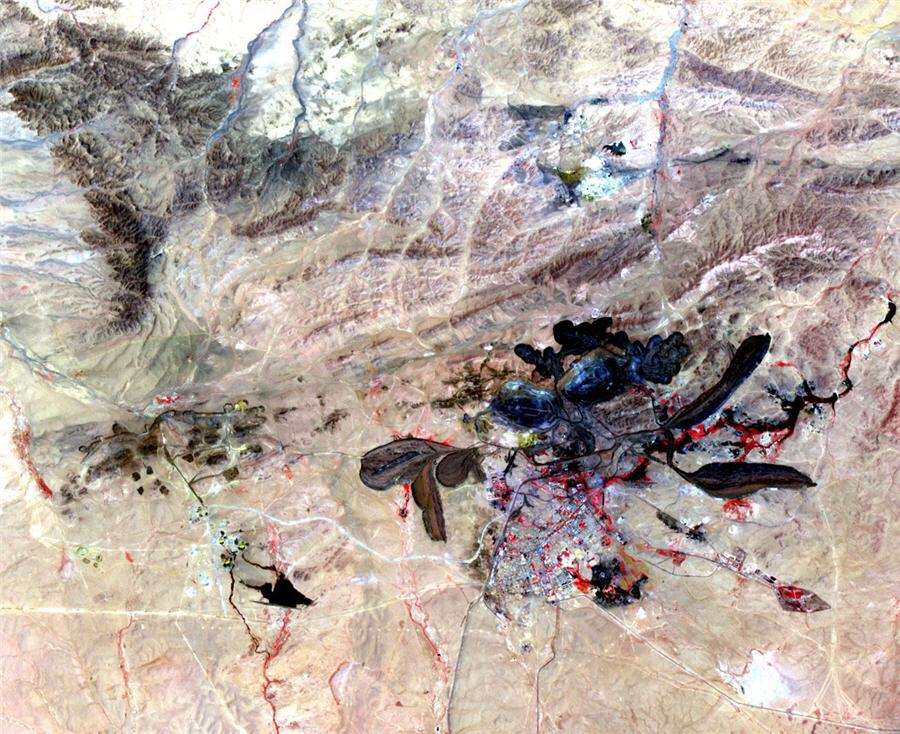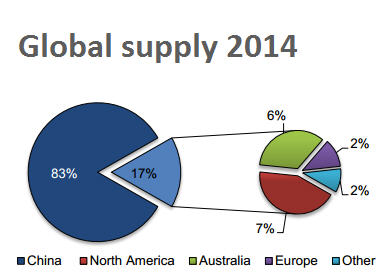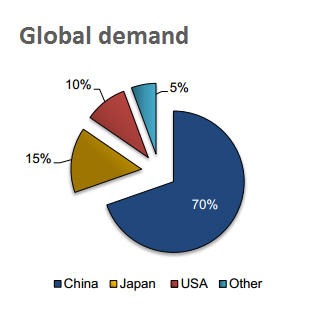
Bayan Obo mine Inner Mongolia China | Source: NASA
Participants in the rare earth industry have been through the grinder over the past decade.
Amid stiff competition for title of commodity with biggest booms and biggest busts (nickel anyone?), rare earths take top honours.
Here’s a quick recap of what brought us here:

Source: Roskill
Now it seems a turnaround may be in the offing.
And again you have China to thank.
Faced with growing discontent at home, China’s new leadership in March declared a war on pollution.
And its low-tech and dirty REE industry is firmly in the crosshairs.
Beijing has been cracking down on the industry for years. But smuggling, environmental devastation and dangerous artisinal mining practices remain rampant.
Some estimates put exports from illegal mining through networks in Vietnam and Hong Kong as highs as 40,000 tonnes, matching China’s annual quotas, further depressing prices.
Beijing is poised to impose a bunch of new environmental regulations including green export certificates and new taxes that are based on the value of the minerals, rather than on volume as is the case at present.
Rare earth production taxes are pegged at RMB60 ($9.14) per tonne mined for light rare earth operations and RMB30 for medium and heavy rare earth operations.
Any increase will mean higher prices at the producer level, particularly for rare earths with greater value such as europium, terbium and neodymium, and a reduction in stockpiles. At least that’s the intention.
Official English outlet China Daily reports the move aims to reflect the scarcity of the minerals (China maintains it only has 23% of the world’s REE reserves even though it still produces more than 80% of the global total) and the impact of extraction.
Businessweek quotes Chen Huan, a rare earth analyst with Beijing Antaike Information Development, a research unit of the state-backed China Nonferrous Metals Industry Association, as saying the new rules could see prices rise more than 20% from current levels.
Higher prices are not just useful for Beijing in terms of better environmental regulation, but as most of the larger miners and processors are state-owned, higher prices affect the bottom line directly
While prices rose and fell more or less in unison, predictions are that prices of the 17 elements may begin diverging more – particularly between lights and heavies. It’s an outlier, but praseodymium prices are already up 60% from a year ago and at times trade for as much as $140 per kilogram oxide.
While not quite as sanguine as other market observers, research house and rare earth authority Metal-Pages also sees signs of a turnaround in REE prices which could occur “across the board in 2015” as supply and demand factors become more balanced.
The London and Beijing-based data provider in its latest outlook cites a number of factors for optimism about prices and the viability of new mining projects outside China:
The lifting of export quotas as mandated by the WTO (China is appealing the ruling, but doesn’t really have a better chance to make its case stick a second time around) is not expected to have an influence on prices.
Exports since 2005 has not even come close to the export ceiling and over the past three years, quotas were more than 20,000 tonnes above actual exports.
What could have an impact is the removal of export taxes on rare earths products which have been raised and widened on several occasions and are now levied at 15% – 20% by the country’s General Administration of Customs.
Roskill Information Services says in a new report scrapping these taxes could affect non-Chinese producers by potentially reducing FOB rare earth prices, and bring it in line with domestic Chinese prices.
The impact, at least in the short term, could be significant as domestic prices were on average 36% below reported FOB prices in April this year according to David Merriman, senior analyst at the London-based metals and minerals consultancy.
However, says Merriman, both FOB and Chinese domestic prices are expected to increase based on new tighter control of production and increasing costs.

Source: Roskill
Another reason why there is room for new producers is the increasing prevalence of captive supply.
Purchasers of raw material that produce downstream rare earths products like powders and magnetic alloys are eligible for a 16% VAT rebate.
That’s one of the reasons Chinese producers like Inner Mongolia Baotou Steel Rare Earth Group and Chinalco have invested heavily in downstream facilities (thanks to its three Chinese plants, Molycorp also happens to be one of the companies benefiting from the rebate).
“Increased captive supply since 2012 has resulted in a greater portion of rare earth raw materials and intermediate products not being made available even to the Chinese domestic market and thus reducing supply for other consumers,” says Merriman.
The biggest longer term threat to the industry is substitution.
Rocketing prices in 2010–2011 sent consumers scurrying to find alternatives and ways to use less with tolerable results.
Metal-Pages says depending on the industry and companies involved consumption fell between 25% – 75%: “One of the most dramatic cases is the reduction in the use of dysprosium in high performance NdFeB magnets. Magnet makers have successfully reduced use by 50-75% and for some magnets or eliminated it all together.”
While much higher prices would be a more than welcome development for the dozens of rare earth explorers and developers that are still out there, another panic in the West on pricing would only lead to long-term demand destruction.
The giant mine in Bayan Obo, Inner Mongolia near Baotou City, produces almost a third of the world’s rare earths and does so as a byproduct of iron ore mining.
This image was taken by the Advanced Spaceborne Thermal Emission and Reflection Radiometer (ASTER) on board the NASA research satellite Terra. The image covers an area of 15 × 19 km.
5 Comments
REE Venture
I’m not quite sure if you believe there could be a turning point, or there is actually a real turning point based on new data.
Also the last paragraph states the consequences of substitution, which could have a negative impact on the ROW REE industry.
You bring positives and negatives at the same time.
Therefore, could you explain to me where you stand at the moment, and why?
Carmonasrocks
Great stuff,hard to understand,neverless the turning point is here…….
Larry Southwick
Dear Mr. Els,
In reading your informative survey article regarding events in the REE industry over the last decade in the Mining.com website on June 17 last, you explain very well how China has been playing a major part in the
changes that have taken place. You mention also that many of the sources for REE in the country are as byproducts
of the iron mining industry. Unfortunately, apparently the need for the iron is greater than the
desire for efficient extraction of the REE’s. These wasteful processes are reportedly causing a rapid
depletion of this unique Chinese resource. The processes result in rare
earths becoming lost in the residues, being made unrecoverable by any
conceivable secondary method.
This resource depletion time bomb is discussed in an article by Jerry Tien of
Missouri, Rolla in the December 2013 issue of Mining Engineering published by
the Society of Mining Engineers. He reviewed the status of rare earth
mining and extraction practices in China. One of his more remarkable
findings was that recoverable rare earth reserves have fallen from 80% of the
world total ten years ago to 52% now. This was due to uncontrolled
illegal mining activities, and wasteful mining and processing practices. There
is fear, as Dr. Tien says, that they “will become a rare-earth poor country, or even a
country without rare earth elements.”
From Dr. Tien’s review, it appears many of the projects extract rare earths from
material excavated primarily to recover iron ores. So although REE’s are a welcome addition to revenues,
unfortunately the iron mines remain iron mines and REE is a secondary
consideration. What REE that is not extracted is thereby left in the residues in a form that depletes the grade
and quality and makes it nearly impossible to recover.
Interestingly, the same thing appears to be happening with their oil shale reserves as well.
One of the primary sources of oil shale is from overburden removed to
access primary coal deposits. This shale must be heated in a retort to
convert it to bitumen which can then be processed in a refinery to make common oil products.
The most common oil shale conversion method in China is a furnace called the Fuson retort, which
is similar to the Paraho process developed in the US over 30 years ago.
It is also similar to Petrobras which has been commercialized in Brazil.
Paraho is also the process that had been undergoing extensive tests for the
last 3-4 years by Queensland Natural Resources in Australia. That project
was recently put on hold due to its projected high costs.
The Fuson retort has a further problem in that it cannot produce all the oil from
the rock because of the way it is designed to operate. So part of the bitumen
is extracted from the overburden and the remainder left in the residues with
even lower grade and in a virtually unusable form.
Here again inefficient extraction methods are degrading and depleting the resource
to permit access to a different material, in this case coal.
As quoted in an interview with REE geology experts the Mariano’s in the August 29,
2013 issue of Mineweb, the biggest hurdle in developing REE deposits outside of
China is economic processing. They say that “The mineralogy will decide
whether you have something with potential. On top of that, miners have to pay
attention to permitting, environmental restrictions, the cost of energy and the
cost of reagents.”
It would seem that these considerations have only a small part to play in much of
the REE (and oil shale) high grading methods used in China. Thereby
China could also be losing a large proportion of their future production
potential by not following typical economic guidelines. A resource that is “free” (to the REE
and oil shale extractors at least, since it is overburden already mined for
other minerals) becomes a “Red Herring” of quick profits even at low
extraction efficiencies. A red herring that encourages the ignoring of
substantial and irretrievable losses of a valuable resource. One wonders
if the reforms being attempted by the government will bring order to the
extraction part of the wasteful practices.
Regards,
Larry M. Southwick, P.E.
Cincinnati, OH
Cavalier
“Demand for high-powered magnets could grow 5%–8% over the next decade”
– Don’t you mean 5%-8% PER ANNUM – over the next decade ….surely? No?
Ken
After doing a little research at Metal-Pages, I see little evidence of any turning point. Since this article was written, just about every rare-earth has gotten cheaper. Check out http://www.metal-pages.com/metals/lanthanum/metal-prices-news-information/ for instance. Lanthanum has declined about 10% or so in the four months since the article. Browse around the other REs and you’ll see for yourself. At best, prices are low and stable. At worst, they are still falling steadily. I’d love to see this come back, but it looks like we’ll need to be patient.